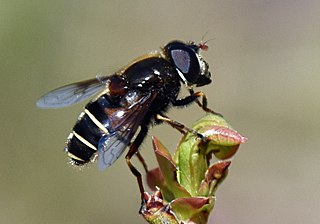Joseph James Fletcher was an Australian biologist, winner of the 1921 Clarke Medal.

The Spanish algyroides, also commonly known as the Spanish keeled lizard or Valverde's lizard, is a species of lizard in the family Lacertidae.

Phasia hemiptera is a fly belonging to the family Tachinidae.

The zebra caterpillar is the larva of an American noctuid moth that feeds on cabbages, beets and other cultivated plants.

Corcobara is a monotypic moth genus of the family Erebidae first described by Frederic Moore in 1882. Its only species, Corcobara angulipennis, described by the same author in the same year, is found in India, Thailand, Cambodia, Myanmar, Malaysia, Indonesia, New Guinea, Sri Lanka and the Solomons.

Eumerus is a genus of hoverflies, within the tribe Eumerini.

Eristalis cryptarum is a holarctic species of hoverfly. Known as the bog hoverfly or bog-dwelling drone fly, it is a bog specialist but may occur in other wetlands. Its larvae are assumed to live in peat that is saturated with water, such as that found in these boggy areas. The female has been observed depositing eggs on and close to very fresh cow dung along oligotrophic seepages in moorland.

Oidaematophorus eupatorii, the eupatorium plume moth or Joe Pye plume moth, is a moth of the family Pterophoridae. It is found in North America, including Florida, Mississippi, Iowa, New York, California and Vancouver Island. It is also known from Mexico, Guatemala and Panama.

Ochromolopis is a genus of moths in the family Epermeniidae described by Jacob Hübner in 1824.

Eristalis flavipes, the orange-legged drone fly, is a species of hoverfly native to North America. It flies from early April to mid-October, and occurs in a wide variety of habitats, particularly wetlands. Hoverflies get their names from the ability to remain nearly motionless while in flight. The adults are also known as flower flies for they are commonly found around and on flowers, from which they get both energy-giving nectar and protein-rich pollen. The larvae are aquatic filter-feeders of the rat-tailed type.

Brachyopa flavescens, The Yellow Sapeater, is a fairly common species of syrphid fly. It has been observed in northeastern North America. Hoverflies get their names from the ability to remain nearly motionless while in flight. The adults are also known as flower flies for they are commonly found around and on flowers, from which they get both energy-giving nectar and protein-rich pollen. Larvae for this genus are of the rat-tailed type. B.flavescens larvae have not been described.

Eristalis anthophorina, the orange-spotted drone fly, is a species of syrphid fly with a Holarctic distribution. It is a common fly in wetlands, including bogs, fens, and woodland pools. In North America, it occurs throughout much of Canada and primarily in the northern parts of the United States. It may be introduced in North America.

Meromacrus acutus, the Carolinian Elegant, is a species of syrphid fly in the family Syrphidae. This uncommon species is distributed in the Eastern United States and South America. Notable for the black and yellow pattern mimicking wasps. Hoverflies get their names from the ability to remain nearly motionless while in flight. The adults are also known as flower flies for they are commonly found around and on flowers, from which they get both energy-giving nectar and protein-rich pollen. The larvae are aquatic filter-feeders of the rat-tailed type. They are found in rot holes of trees.

Blera umbratilis, the Hairy Wood Fly, is an uncommon species of syrphid fly first officially described by Williston in 1887. Hoverflies get their names from the ability to remain nearly motionless while in flight. The adults are also known as flower flies for they are commonly found around and on flowers, from which they get both energy-giving nectar and protein-rich pollen. The larvae are of the rat-tailed type, feeding on exuding sap or in the rot holes of trees.
Hadromyia aepalius, the Sterling Quicksilver, is a rare species of syrphid fly found in eastern North America. Hoverflies get their names from the ability to remain nearly motionless while in flight. The adults are also known as flower flies for they are commonly found around and on flowers, from which they get both energy-giving nectar and protein-rich pollen.

Blera pictipes, the Painted Wood Fly, is a rare species of syrphid fly first officially described by Bigot in 1883. Hoverflies get their names from the ability to remain nearly motionless while in flight. The adults are also known as flower flies for they are commonly found around and on flowers, from which they get both energy-giving nectar and protein-rich pollen. The larvae are of the rat-tailed type, feeding on exuding sap or in the rot holes of trees.
Blera flukei, the Red-cheeked Wood Fly, is a rare species of syrphid fly first officially described by Curran, 1953 as Cynorhina flukei. Hoverflies get their names from the ability to remain nearly motionless while in flight. The adults are also known as flower flies for they are commonly found around and on flowers, from which they get both energy-giving nectar and protein-rich pollen. The larvae are of the rat-tailed type, feeding on exuding sap or in the rot holes of trees.
Chelifera is a genus of flies in the family Empididae.

Meromacrus gloriosus, the Glorious Elegant, is a species of syrphid fly in the family Syrphidae. Originally described from Mexico by Frank Hull in 1941 this black and yellow wasp mimic has since been observed in many locations in Texas and New Mexico.

Chrysotoxum baphyrum is a species of holarctic hoverfly. The adults are strong mimics of wasps. Larvae of this genera, when known, are aphid predators.
















